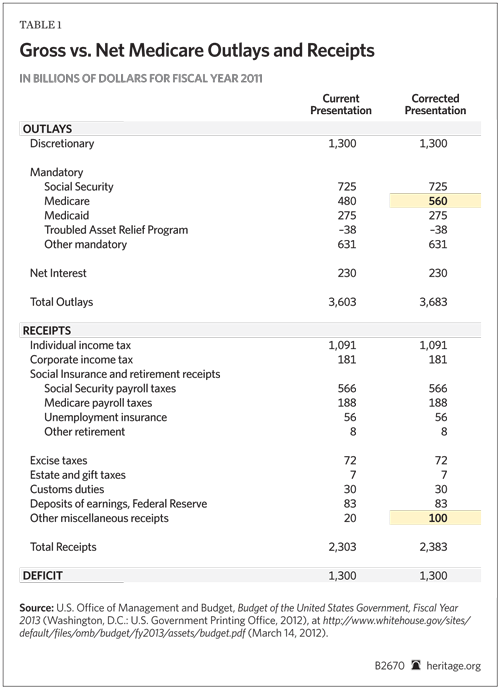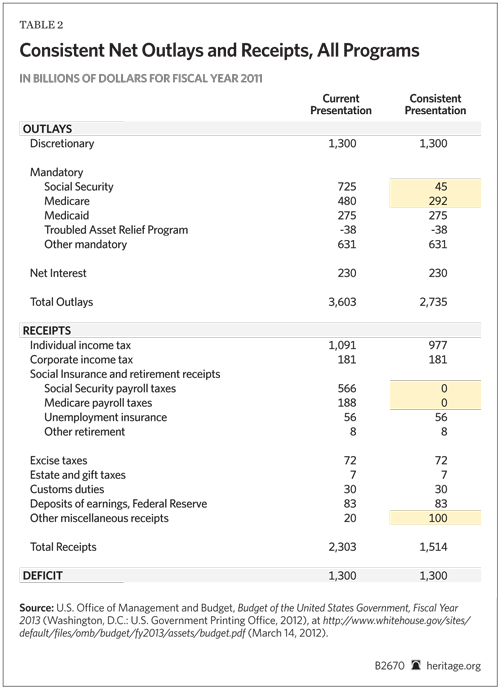Abstract: The President’s budget perpetuates a misleading portrayal of the true magnitude of federal spending. This is most clearly evident in the figures for Medicare spending, which the Office of Management and Budget (OMB) reports as $480 billion for 2011—$80 billion less than the figure reported by the Congressional Budget Office (CBO). The OMB understates Medicare spending by reporting outlays net of offsetting receipts, instead of using a similar method as the CBO in presenting a full picture of all spending and all receipts. The Obama Administration should break with tradition by clearly showing all spending and receipts in its budget so the American people can properly gauge the width and breadth of government policy and the consequences of upcoming reforms.
The level of total federal spending and revenues and any resulting budget deficit are the most fundamental dimensions of fiscal policy, yet the President’s budget as presented by the Office of Management and Budget (OMB) substantially understates total Medicare outlays and thus the total level of federal spending.[1] The understatement, amounting to some $80 billion for 2011 alone, is not unique to the Obama Administration, which continues the practice of Administrations past. In contrast, the federal budget presentation from the Congressional Budget Office (CBO) provides a more intuitive, more transparent picture of total spending. While obviously an important issue, the budget’s presentation of Medicare will become even more important as the nation grapples with Medicare reform in the years immediately ahead.[2]
Official budget presentations should be accurate and transparent so the American people and policymakers can better understand the full scope of federal government activities. The Administration should adopt the CBO approach in this regard and show the true magnitude of federal spending and receipts.
Distinguishing Total from Net Medicare Spending
According to the President’s budget, total outlays for Medicare in 2011 were $480 billion, yet the CBO reports total Medicare outlays of $560 billion. Both figures are obviously correct in some sense, yet even by Washington standards an $80 billion gap between two official presentations for a year already in the books is remarkable.
Nor is Medicare unique in this respect. The President’s budget fails to show a lot of federal spending and receipts—nearly $550 billion worth in 2011.[3] To provide some context, this amount exceeds all Defense Department spending in 2011 not directly related to the wars in Iraq and Afghanistan.
The difference between the OMB and CBO figures for Medicare is attributable to “offsetting receipts.” The OMB shows Medicare outlays net of offsetting receipts, whereas CBO shows total outlays and reports offsetting receipts along with other receipts. It would be like a two-earner family in which the husband’s income is used to pay the mortgage and the wife’s income covers all other family bills and provides for the family’s net saving. Normally, a family budget combines the income of the spouses and combines the mortgage (or rent) with other expenses to arrive at total spending. This is the way the CBO shows Medicare.
The OMB’s version of the family budget, on the other hand, would show only the wife’s income and the nonmortgage expenses. The family’s net saving is reported the same either way, but the CBO version, which reports all income and all outlays, is clearly the more natural, more transparent approach.
The bulk of the $80 billion in offsetting receipts in 2011 was the nearly $63.4 billion in premium income that Medicare received from beneficiaries, and the remainder was primarily from income tax receipts credited to Medicare from the taxation of certain benefits. Participants in Medicare’s Supplemental Medical Insurance program, more commonly known as Medicare Parts B and D, pay premiums to cover a portion of the program’s cost. In 2011, most participants paid $96.40 or $110.50 per month for Part B, and the average monthly premium for Part D was $55.36.[4]
In the OMB figures, offsetting receipts such as Medicare premium income are subtracted from total Medicare outlays. This means the figure in the budget is not total Medicare spending as might be presumed from and as is suggested by the headings in the various tables. Rather, the budget presents a measure of the net spending on Medicare that must be financed through other means besides premiums, such as payroll tax receipts and transfers from the General Fund. This is a valid and useful concept, but not the most important, nor the one expected by the reader or suggested by the headings.
Calculating True Net Medicare Outlays
Budgets are management tools for policymakers and information sources for citizens. They should be as transparent and intuitive as possible given the enormous complexities involved in the programs themselves and the related concepts. The budget provides two internally consistent presentations for Medicare. One transparent presentation separates Medicare offsetting receipts as is done by the CBO, showing total Medicare outlays rather than net outlays in determining total governmental outlays. Premium income and similar offsetting receipt income are then shown as a separate line in receipts, where it belongs. This presentation gives an accurate picture of total government spending and receipts without changing the calculation of the budget deficit.

Alternatively, one could present net Medicare outlays to show the net drain of various programs like Medicare on the general resources available to the federal government. The presentation of Medicare in the President’s budget is an incomplete step toward this net effects approach. If this latter approach is preserved, then additional adjustments to the reporting of Medicare, Social Security, and possibly other programs may be necessary.
For example, the argument for netting out Medicare premium income is that these are payments for current services within a defined program. This is analogous to any program in which the government provides a service for which it charges a user fee. A simple example is the entry fee charged when visiting a national park.
Applying this approach consistently creates a difficulty, specifically in the treatment of the Medicare payroll tax. A 2.9 percent payroll tax is levied to fund the Hospital Insurance (HI) or Medicare Part A. Revenues from the HI payroll tax cover current HI program expenses with any excess or deficiency working through a modest trust fund. However, payment of the tax qualifies workers to receive Part A benefits in retirement at no additional cost. The tax effectively is a prepayment of their premiums for Part A insurance, whereas the current premiums for Parts B and D are paid for current insurance.
Considered in this light, adopting the net effect approach to budgeting implies that the treatment of Medicare should reflect total outlays net of all offsetting receipts—both premiums and $188 billion in payroll tax income.[5] The effects on the budgetary presentation of such a change would be profound. If the payroll tax is treated as an offsetting receipt, then Medicare’s outlays as reported in the budget would drop by $188 billion. Instead of the $480 billion shown in the President’s budget for Medicare outlays in 2011, reported outlays would fall to about $292 billion.
If one fully applies the netting of Medicare expenses and treats the Medicare payroll tax as prepaid premiums, this would warrant a further fundamental change in the budgetary treatment of Social Security. Like Medicare Part A, Social Security pays current benefits to retirees out of the 12.6 percent payroll tax levied on the wages of current workers.[6] However, from the worker’s perspective, future benefits are calculated based on the individual’s income history and are portrayed as being prefunded through payroll taxes during their working years. If Medicare payroll tax revenue is treated as an offsetting receipt against Medicare outlays, then Social Security payroll tax revenue should be treated as an offsetting receipt against Social Security outlays. This would reduce the reported budget figure for Social Security outlays from $725 billion to about $45 billion, about a 94 percent reduction. Obviously, this method would significantly misrepresent the size of Social Security in the budget, just as it would misrepresent Medicare, as shown in Table 2.

The clear implication is that this is not a sensible approach for reporting either Social Security or Medicare outlays and receipts, leaving the CBO approach as the sensible alternative.
An Accurate Reflection of Federal Spending and Revenues
Budget policymakers and citizens need a clear representation of total outlays, total revenues, and the total deficit for the overall budget. They also need a transparent representation of the specific financial condition of each program. This, in fact, is implied by the summary budget tables in the President’s budget. For example, Table S-1 refers to “Budget Totals,” whereas the subcategories in Table S-3 are labeled “Total outlays” and “Total receipts.”[7] These quantities are what these budget tables should present, which means total outlays for Medicare should be included and shown, and premium income should be shown and tabulated separately as an offsetting receipt. These budget tables should follow the CBO practice in this and should not show the programs’ net spending.
Although the most correct approach is to follow the CBO’s methodology of displaying total outlays by showing gross Medicare spending in the primary budget tables, it is also appropriate to use supplementary tables to display the net drain that programs such as Medicare and Social Security impose on available budgetary resources. This could mean correcting the treatment of Medicare and Social Security payroll taxes as described above because they are effectively prepaid premiums.
Thus, including Medicare gross outlays in the budget’s tables is clearly the correct approach, whereas netting out offsetting receipts for Medicare (and Social Security) is appropriate only as supplemental information, provided the table clearly notes that the future benefits promised by these premiums are not guaranteed.
Importance for Medicare Reform
One implication of the budget’s current Medicare presentation relates to a policy of increasing Medicare premiums, a commonly suggested remedy to Medicare’s funding shortfall. This policy is included in the President’s latest budget.[8] Such a policy would reduce the drain that Medicare imposes on the General Fund of the Treasury. The General Fund, which receives individual and corporate income tax revenues along with certain other types of revenue, subsidized Medicare spending by about $222 billion in 2011. Raising premiums would mean that beneficiaries would cover more of their own health insurance costs, thereby reducing Medicare’s claim on the Treasury. Higher premiums would reduce Medicare’s immediate drain on the Treasury, reduce federal budget deficits, and reduce the extent of underfunding for Medicare in the medium and long terms.
Importantly, as the President’s budget is currently constructed, a policy of raising Medicare premiums would also misleadingly imply a policy of reducing Medicare spending. In fact, total Medicare outlays would remain unchanged; only Medicare’s claim on other resources would be reduced.
Similarly, raising premiums would then also imply total government spending had been reduced. This would not be the case. Total government spending would be unaffected by higher Medicare premiums, although the offsetting receipts would reduce the deficit.
This problem does not afflict a budget in which total outlays and receipts are recorded properly as is done by the CBO. In this case, an increase in Medicare premiums, for example, leaves total Medicare spending unchanged, but reduces the budget deficit by adding to an explicit accounting of offsetting receipts.
Accurately Reporting and Budgeting for Medicare
The federal budget should present policymakers and citizens with the plain facts. When the budget presents a figure for the outlays associated with any program, the implication is that these are the total expenditures associated with that program. Yet this is not the case with Medicare, for which the President’s budget shows a net outlay figure. Therefore, the budget presentation inadvertently misleads with respect to the second largest single federal program. Absent a compelling argument to the contrary, all federal programs should appear in the primary budget tables with their total outlays and their offsetting revenue sources shown separately. Where there is value in identifying the specific claims of the program on other resources, those can be shown in separate presentations.
Medicare is the largest, but not the sole example of this misrepresentation. Table 16-1 in the Analytical Perspectives volume of the budget and subsequent discussion detail the total of $549 billion in “Total, offsetting collections and offsetting receipts from the public” received by the federal government in fiscal year 2011.[9] In addition to the receipts associated with Medicare, these additional offsetting receipts include $66.5 billion from selling postage stamps and collecting other postal service fees. Another $36.7 billion was income accrued to the Tennessee Valley Authority for the sale of energy.[10]
To put the total figure for offsetting collections and receipts in some perspective, the budget reported that federal receipts in 2011 totaled $2,303 billion, a huge figure that does not include the $549 billion in offsetting collections and receipts. Thus, about 19 percent of total federal receipts and collections were excluded from the combined tally.
When government is engaged in business activities—whether Medicare, the postal system, energy generation, or otherwise—the total expenses associated with these activities should be included in the total outlays of the government, and the offsetting receipts should be shown among the receipts of the government. There would be no net effect on the reported deficit, but the statement of government activities would be far more transparent.
The logic of presenting gross outlays is further laid bare by a hypothetical example. If the federal government were to nationalize an entire industry representing 10 percent of the nation’s economy (about $1.5 trillion) and the industry was operating at a loss of $150 billion, the government would henceforth subsidize that amount out of its other resources. Using the approach now employed in the President’s budget, federal spending and the budget deficit would appear to increase by only $150 billion even though the government has taken control of 10 times more income and output. A much more transparent presentation would show a $1.5 trillion increase in spending, a $1.35 trillion increase in revenues, and a $150 billion increase in the deficit.
Conclusion
The federal budget presentation released each year by the Office of Management and Budget and parallel presentations offered by the Congressional Budget Office are vital components of the policymaker’s toolbox and key sources of the citizen’s information in the national debate about the proper size and scope of government. Yet the information that the budget presents on Medicare and other programs is badly misleading, leading to a fundamental misrepresentation of the true size of government as measured by income and spending. Following the CBO’s approach would remedy these mistakes.
The Obama Administration should break with tradition and correct these presentations by clearly showing all spending and receipts so the American people can properly gauge the width and breadth of government policy and the consequences of upcoming reforms.
—J. D. Foster, Ph.D., is Norman B. Ture Senior Fellow in the Economics of Fiscal Policy in the Thomas A. Roe Institute for Economic Policy Studies at The Heritage Foundation.

